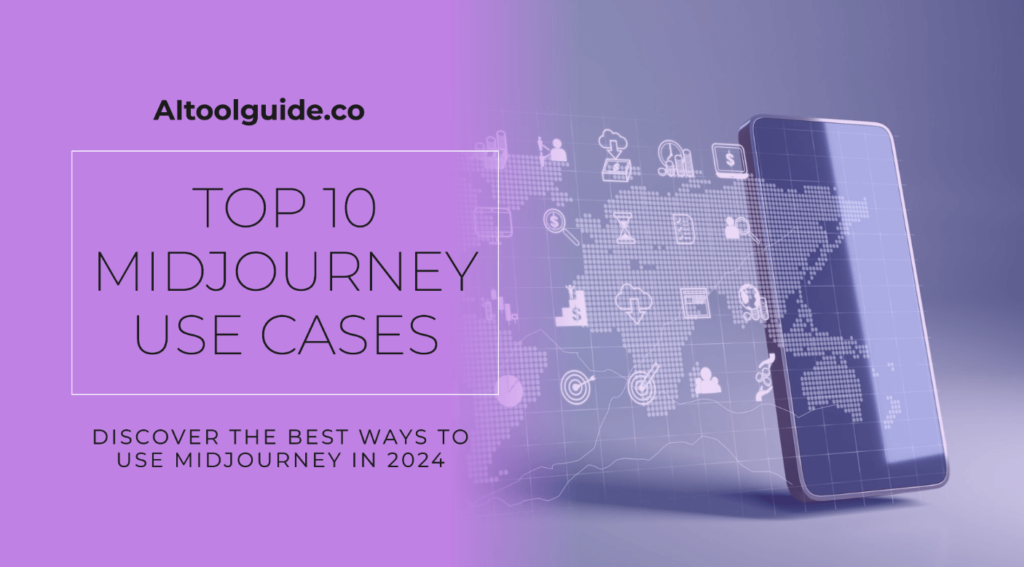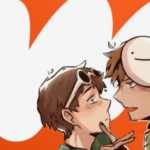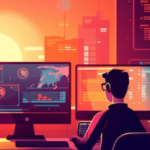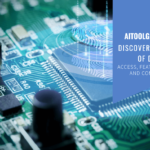Midjourney is a cutting-edge AI art generator that’s shaking up the creative world. Founded by David Holz, this San Francisco-based startup uses natural language prompts to create stunning visuals.
Since its open beta launch in July 2022, Midjourney has gained millions of users, becoming the biggest active Discord server.
It works by combining large language models and diffusion models to turn text into eye-catching images. Unlike some AI tools, Midjourney focuses on painterly aesthetics rather than photorealism. It’s changing how artists work, helping them brainstorm ideas faster and explore new styles.
While some worry it might replace human artists, many pros use it to boost their creativity. Midjourney is more than just an art tool – it’s expanding our imagination and reshaping how we think about creativity in the digital age.
Top 10 Practical Use Cases of Midjourney
1. Graphic Design and Branding
Midjourney helps businesses create eye-catching visuals that make them stand out in a crowded market. With this AI tool, you can whip up logos, social media posts, and marketing materials in no time flat.
Let’s say you’re a small business owner looking to create a new logo. Instead of spending hours sketching ideas or hiring an expensive designer, you can use midjourney.
Just type in what you want, like “a modern logo for a coffee shop with a mountain theme,” and boom! You’ll get four different designs in about a minute. That’s way faster than doing it by hand!
Big companies are using Midjourney too. Heinz, the ketchup folks, used it to make cool ads. They asked Midjourney to imagine what ketchup would look like if it grew on trees.
The results were wild and got people talking about Heinz online. But it’s not just about speed. Midjourney helps you try out different styles and ideas quickly.
You can play around with colors, shapes, and vibes until you find the perfect look for your brand. It’s like having a super-creative friend who never gets tired of brainstorming with you.
Some people worry that AI might replace human designers, but that’s not happening. Instead, many pros use Midjourney to boost their creativity.
It helps them come up with fresh ideas and do the boring parts of design faster. This leaves more time for the fun, creative stuff that humans are best at.
With Midjourney, even small companies can have pro-level designs without breaking the bank. It’s leveling the playing field and helping businesses of all sizes look their best.
2. Product Visualization
Midjourney is like having a magic wand that can show you what products will look like before they even exist! This is super helpful for businesses of all sizes. Imagine you’re designing a new sneaker.
With Midjourney, you can create realistic 3D mockups in minutes. You can try out different colors, materials, and designs without making a single physical sample. This saves tons of time and money.
Furniture companies love Midjourney too. They use it to show customers how a new couch or table would look in different rooms. It’s like virtual home staging, but way cooler and easier to do.
E-commerce businesses are big fans of Midjourney. They use it to create product photos that look amazing. This helps them sell more stuff online. After all, people are more likely to buy something if it looks good in pictures.
A jewelry designer used Midjourney to create images of new necklace designs. She got 50 different ideas in just one afternoon. Before, it would have taken her weeks to sketch out that many designs by hand. Midjourney isn’t just for big companies either.
Small businesses and startups use it to make their products look super professional without spending a fortune on photography or 3D modeling. Even architects and real estate agents are getting in on the action.
They use Midjourney to show what buildings will look like before they’re built. It’s like having a crystal ball that shows the future! The best part? You don’t need to be a tech whiz to use Midjourney. It’s pretty easy to learn, and there are lots of tutorials online to help you get started.
3. Concept Art for Entertainment
Midjourney is shaking things up in the world of entertainment. It’s become a secret weapon for creating awesome concept art for movies, TV shows, and video games.
Think about your favorite sci-fi movie. All those cool alien worlds and futuristic cities? Midjourney can help create those kinds of mind-blowing visuals super fast. It’s like having a whole team of artists at your fingertips.
Game developers are using Midjourney to dream up new characters and levels. They can type in something like “a steampunk robot pirate captain” and get a bunch of amazing designs in seconds. This helps them try out lots of ideas quickly and pick the best ones.
Movie studios are getting in on the action too. They use Midjourney to visualize scenes before they start filming. This helps everyone on the team get on the same page about how things should look.
An indie filmmaker used Midjourney to create concept art for their low-budget sci-fi movie. They got images that looked like they cost millions of dollars to make, but it only took a few hours and didn’t cost much at all.
Comic book artists are using Midjourney to come up with new superhero designs and wild alien worlds. It’s helping them push their creativity to new levels. Even theme parks are using Midjourney.
They use it to design new rides and attractions. It helps them show what the rides will look like before they spend millions building them.
The best part? Midjourney can help create art in all sorts of styles. Want something that looks like an old oil painting? No problem. How about a neon-lit cyberpunk city? Midjourney’s got you covered.
4. Illustration and Storytelling
Midjourney is a game-changer for illustrators and storytellers. It’s like having a magic pencil that can bring your wildest ideas to life in seconds.
Imagine you’re writing a children’s book about a friendly dragon. With Midjourney, you can type in a description of your dragon and get a bunch of colorful, fun illustrations right away.
This helps you see what your characters look like as you’re writing the story. Comic book creators are using Midjourney to design new characters and dream up crazy new worlds.
They can experiment with different art styles super fast. Want to see what your superhero would look like if they were in a manga?
Just ask Midjourney! Bloggers and content creators love Midjourney too. They use it to make eye-catching images for their articles and social media posts. This helps them get more people to read their stuff.
A fantasy author used Midjourney to create maps for their book series. They got detailed, professional-looking maps that made their made-up world feel real to readers. Teachers are getting in on the action too. They use Midjourney to make fun illustrations for their lessons.
This helps keep students interested and makes learning more fun. Even board game designers are using Midjourney. They use it to create art for their game cards and boards. This helps them test out different looks for their games before they hire an artist to do the final artwork.
The best part? Midjourney can help with all kinds of storytelling. Want to make a graphic novel? Midjourney can help with that. How about a visual poem? Yep, Midjourney’s got you covered there too.
5. Web and Mobile Design Elements
Midjourney is changing the game for web and mobile design. It’s like having a super-smart design buddy who can whip up cool graphics in seconds. Imagine you’re making a new app.
You need icons, buttons, and backgrounds that look awesome. With Midjourney, you can describe what you want and get a bunch of options right away. This helps you try out different looks without spending hours drawing everything by hand.
Web designers love Midjourney because it helps them create unique header images and backgrounds. They can make websites that really stand out from the crowd. No more boring stock photos!UI/UX designers use Midjourney to come up with new ideas for user interfaces.
They can quickly test different color schemes and layouts. This helps them make apps and websites that are both pretty and easy to use.
Here’s a cool example: A startup used Midjourney to design all the icons for their new fitness app. They got a set of fun, colorful icons that made their app look professional and inviting.
It only took them a few hours, and they didn’t have to hire an expensive design agency. E-commerce sites are using Midjourney to create eye-catching product images and banners.
This helps them sell more stuff because their online stores look amazing. Even game developers are getting in on the action.
They use Midjourney to design menu screens, loading screens, and in-game UI elements. This helps make their games look polished and professional. The best part? Midjourney can help with all kinds of design styles. Want something minimalist and clean?
No problem. How about a funky retro look? Midjourney’s got you covered. Some folks worry that AI might replace human designers, but that’s not happening. Instead, it’s helping designers work faster and come up with even cooler ideas. It’s like having a superpower for creativity!
6. Marketing and Advertising
Midjourney gives you access to a whole team of creative geniuses who are ready to create awesome ads in a matter of seconds. Think about all the ads you see every day.
With Midjourney, companies can make eye-catching social media posts, banner ads, and even billboards super fast. This helps them try out lots of different ideas and pick the best ones.
Small businesses love Midjourney because it helps them compete with big companies. They can make professional-looking ads without spending a fortune on designers.
It’s leveling the playing field! Digital marketers use Midjourney to create infographics and data visualizations. This helps them explain complicated stuff in a way that’s easy to understand and fun to look at. Here’s a cool example: A local pizza shop used Midjourney to make a series of funny ads for social media.
They got tons of likes and shares, and more people started coming to their restaurant. All because of some creative AI-generated pictures! Email marketers are using Midjourney to make their newsletters more interesting. They can create custom images for each email, which helps more people open and read them.
Even big brands are getting in on the action. Coca-Cola used AI (including tools like Midjourney) to create ads for their “Masterpiece” campaign. The ads looked like famous paintings but with Coke bottles in them.
It got people talking and sharing the ads online. The best part? Midjourney can help with all kinds of marketing styles. Want something sleek and modern? No problem. How about a vintage look? Midjourney’s got you covered.
7. Fashion and Apparel Design
Midjourney is a hot trend in the fashion and apparel industries. You get an instant fashion designer who can come up with new ideas in seconds. Imagine you’re designing a new t-shirt line. With Midjourney, you can type in your ideas and get a bunch of cool designs right away.
This helps you try out different looks without spending hours drawing everything by hand. Fashion designers are using Midjourney to come up with new patterns and styles. They can experiment with wild color combinations and unique shapes that they might not have thought of on their own.
Costume designers for movies and theater love Midjourney too. They use it to visualize outfits for characters before they start making them. This helps them show directors and actors what they’re planning.
A small clothing brand used Midjourney to design a whole collection of streetwear. They got a bunch of unique, eye-catching designs that looked like they came from a big fashion house. It helped them stand out in a crowded market. Shoe designers are getting in on the action.
They use Midjourney to try out different colors and materials on shoe designs. This helps them make decisions faster and come up with more creative ideas.
Even accessories designers are using Midjourney. They create new designs for things like bags, jewelry, and hats. It’s helping them push the boundaries of what’s possible in fashion.
The best part? Midjourney can help with all kinds of fashion styles. Want something high fashion and avant-garde? No problem. How about comfy casual wear? Midjourney’s got you covered.
8. Interior Design and Architecture
With Midjourney, you can visualize what a room or building will look like before it is ever built from any location in the world! Imagine you’re redecorating your living room. With Midjourney, you can type in your ideas and see different design options right away.
This helps you try out different colors, furniture, and layouts without moving a single piece of real furniture. Interior designers love Midjourney because it helps them show clients what their ideas will look like. They can create realistic images of rooms with different styles, colors, and furniture.
This makes it easier for clients to understand and get excited about design plans. Architects are using Midjourney to visualize buildings before they start construction.
They can quickly test different designs and see how buildings will fit into their surroundings. This helps them make better decisions and avoid costly mistakes.
A hotel chain used Midjourney to redesign their rooms. They created images of different room styles and asked customers which ones they liked best. This helped them make rooms that guests really love, without spending a ton of money on test rooms.
Real estate agents are getting in on the action too. They use Midjourney to show what empty houses could look like with furniture. This helps potential buyers imagine themselves living there.
Even landscape designers are using Midjourney. They create images of gardens and outdoor spaces to show clients what their yards could look like in different seasons.
The best part? Midjourney can help with all kinds of design styles. Want to see what your room would look like with a minimalist style? No problem. How about a cozy farmhouse look? Midjourney’s got you covered.
9. Educational Content Creation
Using Midjourney’s tools, education is about to undergo a revolution. It’s like having a super-smart artist and a teacher rolled into one. Imagine you’re a teacher trying to explain how volcanoes work.
With Midjourney, you can create amazing images of volcanoes in action, cross-sections showing what’s inside, and even fun cartoon characters to help explain things.
This makes your lessons way more interesting for students. Textbook publishers are using Midjourney to create better illustrations for their books. They can make complex ideas easier to understand with clear, colorful pictures. This helps students learn faster and remember more.
Online course creators love Midjourney because it helps them make eye-catching thumbnails and graphics for their videos. This makes their courses look more professional and attracts more students.
A science teacher used Midjourney to create a series of images showing the life cycle of a butterfly. The pictures were so beautiful and detailed that students were excited to learn about metamorphosis.
Language learning apps are getting in on the action too. They use Midjourney to create fun illustrations that help people remember new words and phrases.
It’s like having flashcards that are always fresh and interesting. Even museums are using Midjourney. They create interactive displays that show what ancient artifacts might have looked like when they were new.
This brings history to life in a way that’s really exciting for visitors. The best part? Midjourney can help with all kinds of subjects. Need to explain math concepts? No problem. Want to show how the human body works? Midjourney’s got you covered.
10. Print-on-Demand Products
With Midjourney’s AI tool, you can whip up t-shirts, mugs, posters, and more in no time. It’s like having a super-creative artist on speed dial. Let’s say you want to make a funky dinosaur t-shirt.
Just tell Midjourney what you want, like “cute baby dinosaur in outer space,” and boom! You’ve got a bunch of cool designs to choose from. It’s that easy!
Rob Cubbon, a solo business owner since 2005, says Midjourney is great for making Amazon Print on Demand t-shirt designs and even coloring book pages.
He uses prompts like “/imagine: a printable black and white coloring page featuring [subject], clean line art –ar 17:22” to create awesome coloring books. And get this – you can make about 30-50 pages super fast!
Benefits of Using Midjourney
Midjourney offers real value in terms of saving time and money while boosting creativity. Let’s talk about how it’s a time-saver first. Imagine you’re a graphic designer working on a new logo. Instead of spending hours sketching ideas, you can use Midjourney to whip up a bunch of cool designs in just minutes.
It’s like having a super-fast brainstorming buddy! Rob Cubbon, a solo business owner, says he can make about 30-50 coloring book pages super quick with Midjourney. That’s a lot of work done in no time flat!
Now, let’s chat about how it’s cost-effective. With Midjourney, even small businesses can create pro-level designs without breaking the bank.
You don’t need to hire a whole team of artists or buy expensive software. Just type in what you want, and boom! You’ve got awesome art. This levels the playing field, helping everyone look their best online.
But here’s the really cool part – Midjourney is all about expanding creative possibilities. It’s like having a magic wand that can bring your wildest ideas to life. Want to see what a dinosaur would look like riding a skateboard on Mars?
Midjourney can show you! This helps artists and designers think outside the box and try new things. In fact, 68% of Midjourney users say they use it just for fun, exploring all sorts of crazy ideas. And for the 32% who use it for work, it’s helping them push the boundaries of what’s possible in their designs.
Conclusion
Midjourney is changing the game for creatives everywhere! From whipping up cool t-shirt designs to dreaming up wild movie characters, this AI tool is like a super-smart art buddy. It’s not just for big shots either – even small businesses are using it to look awesome online.
With over 20 million users and growing fast, Midjourney is here to stay. Whether you’re a teacher making fun lesson plans or a fashion designer trying out new styles, Midjourney’s got your back. It’s saving folks time and money while helping them think outside the box.
So, whether you’re a pro or just love making cool stuff, give Midjourney a shot. Who knows? You might just create the next big thing!
- Guide to Connect Claude AI with Google Sheets in 2024 - October 11, 2024
- What is DreamGF? Honest review by Expert - October 9, 2024
- How to Use Claude AI in 2024? - October 7, 2024






